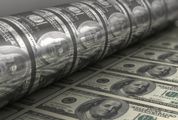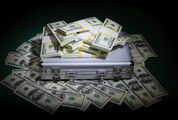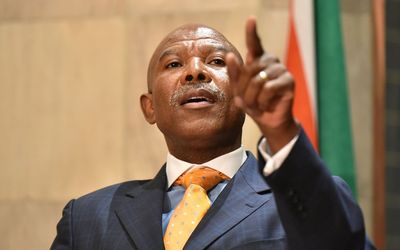THE monetary policy committee of the South African Reserve Bank decided to raise the repurchase rate 0.25 of a percentage point to 6.25% on Thursday, despite an obviously negative outlook for growth in SA. At 1.5% expected gross domestic product growth and core inflation of 5.2%, we’re hardly looking for restraint.
I guess our rate hike was, at least in part, a pre-emptive strike in anticipation of the now almost certain rate hike expected from the US Federal Reserve on December 16 — an illiquid time for our rand. It did have the immediate desired effect of strengthening our currency.
All well and good within a macro-economic debate, for now. If, however, this signifies the beginning of a rate-increasing cycle, then I’m not sure our over-geared consumers are going to cope. There are only two kinds of people in the world, you might say — those who embrace debt and those who don’t. There was a time, not so long ago, when poor people simply couldn’t borrow money. Many, myself included, would say that those were the good old days.
If you simply didn’t have the capacity for debt, then somehow the yearning eventually subsided and you coped without it. That, for whatever inexplicable reason, has changed.
Everybody can borrow money now. For most people, once you do, you’ll never look back; never get out of it and you’ll always live beyond your means. Most people spend most of their economically active lives managing debt and leaving the residual assets to their descendants.
Very few people reach preretirement with an unencumbered net asset value. They have to downsize, realise the equity in their homes and add that to the lump sum portion of their retirement benefits, to secure some sort of steady state lifestyle — which then often lasts longer than initially anticipated. For most of us, "Neither a borrower nor a lender be" remains the preserve of those fortunate few who can afford such virtue.
The prime drivers of debt are necessity and aspiration. More often than not, the first time people get into debt is for the sake of others, mostly family — to buy a bigger house or a bigger car, or to put your kids on the right side of the railway line by providing education at a level above that which you had. This is one of the unfortunate consequences of our dual economy. For those who can afford the cost of private education, security, healthcare and so on, it comes at a cost that is a multiple of the subsidised alternative for the masses. Few can afford it without some debt.
Debt is a curious animal; if jealousy is the green monster, then debt is its close red cousin. Be careful not to envy the apparently wealthy — behind many a fast car or fabulous pair of high heels is often an invisible mountain of debt, kept just below the surface, ready to pounce at the first missed instalment. People don’t wear their liabilities on their sleeves, you’ll only see the asset side of their balance sheets on show. Net asset values differ vastly from one BMW owner to another, so be selective of who you envy.
The real challenge of debt, however, is in the income statement. Balance sheet values are more often than not a matter of opinion. Interest, on the other hand, has to be settled every month, in cash. Cash is the truth drug of economics. If you don’t pay your creditors you give them rights.
Company debt is different, but the same. Company debt, in a limited liability structure, is over there, not here, not in your pocket or out of it. Resilient, tried-and-tested ratios that have stood the test of time are what drives corporate creditworthiness. There are two aspects — the assets that generate the income required to service the debt and the people in charge of those assets. If either is absent, you won’t get the money.
Banks used to be the only places where debt was allowed to be a big multiple of equity, like 10 times, and that’s why they are appropriately regulated. A reminder of Banking 101: 10% equity and 90% deposits fund 100% loans. At a 2% margin that yields a 20% return on equity.
Then came the disintermediators, particularly when their primary source money was really cheap because of quantitative easing. Hedge funds have different oversight and a much higher risk appetite — that’s their purpose, nothing wrong with it. So, disintermediation of the banks was inevitable, but this new debt came at a price.
Countries are, of course, a different matter altogether. The Fed, European Central Bank and Bank of Japan, among others, are where the trouble started. Easy money has been the order of the day for almost a decade now. Although SA didn’t use much of it to build much, the emerging market countries as a group, and China in particular, accessed cheap excessive capital, but ended up building excessive capacity with it. In time, the cycle will turn, but for now, supply exceeds demand in the real economy and the interest rate cycle is about to turn — upwards. That’s a double whammy.
The yield seekers who took their easily gotten money in the developed world and lent it to the high-yield promise of the emerging markets, are soon enough going to take it home. The recent trend of developed market deleverage balanced by emerging market leverage, is about to reverse. It couldn’t come at a worse time.
But there is a built-in pressure release valve for sovereign states: their currency exchange rate. As cheap money finds its way from developed markets to emerging markets, local currencies strengthen. This doesn’t auger well for those export industries built with loans from that cheap hard-currency funding.
To compete, export-enthusiastic, or even dependent, countries will print enough money to weaken their currencies to make their exports more competitive (not much fun if you’re running a trade deficit or you’re an importer).
In truth, I’m not sure that making all this easy money ever had anything to do with the real economy.
I think it’s as simple as this: the US has more debt than it can ever manage to repay, ever. Faced with an increasingly strong dollar, the real value of this debt just kept on increasing, the compounding effect of which was to make the US both less competitive and less able to deal with its debt pile. Trying to stimulate the world just sounded like a better story than admitting super-indebtedness.
Circles and waves ebb and flow in the bubble bath that is the world financial economy. It won’t change and lessons won’t be learnt as we inevitably keep moving through the cycles.
Debt is cheaper than equity, as long as you can afford it.
Debt has its place in the efficient capital model of a firm. Leverage is good, but only in the right proportions and in a term-matched, asset-liability structure.
Personally, you’re best advised to make do without debt — but where’s the fun in that?





















Data supplied by Profile Data
Data supplied by Profile Data
Data supplied by Profile Data
Data supplied by Profile Data